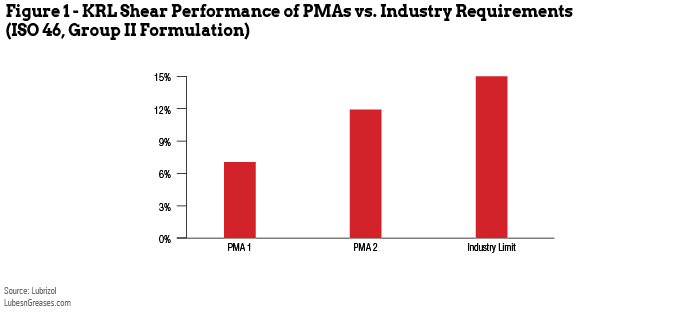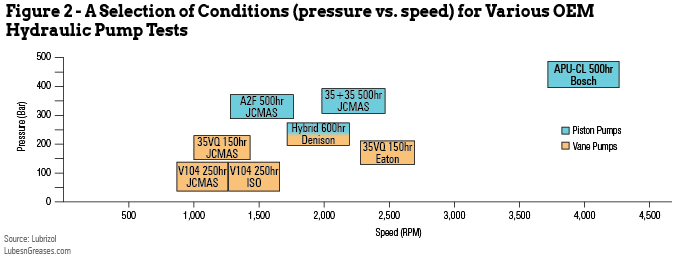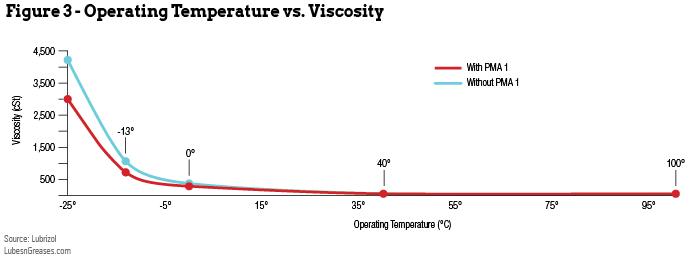Performance Polymers Can Help to Augment Hydraulic Fluid Performance.
The world is constantly moving in the direction of increasing productivity while maintaining a need for reliability. This is especially true for anyone operating hydraulic equipment. As a result, the correct selection of hydraulic fluid for use in any given environment is becoming more important. Operators of equipment that rely on hydraulic power are under pressure to keep their machines running at higher levels of performance—often around the clock—thus increasing demand on the hydraulic fluids that are essential to the protection, productivity and smooth running of these machines.
The correct choice of hydraulic fluid is essential to ensure effective power delivery and unhindered operation. No matter the operating conditions—whether in subzero temperatures or sweltering, humid heat—the hydraulic fluid must keep systems operating properly, minimize downtime and ensure the confidence that operators and owners demand.
A successful hydraulic fluid must:
- Perform robustly under all conditions at the job site.
- Protect and extend the life of critical and costly hydraulic components, like pumps and motors.
- Help prevent unscheduled downtime and maximize equipment productivity.
- Help reduce operating costs.
While most traditional hydraulic fluids have worked in the past, today’s more demanding conditions require manufacturers to augment their performance. This article will explore the role performance polymers—also known as viscosity modifiers—can play in offering today’s hard-working machines more effective lubrication as the demands on equipment continue to increase.
To formulate hydraulic fluids capable of functioning in a vast range of applications and across widely varying climatic conditions requires the introduction of a suitable performance polymer that is complementary with other additives used in the fluid.
Choosing the right polymer and additive package will ensure effective hardware protection and successful, uninterrupted use of the hydraulic equipment across seasons and geographic zones.
How Performance Polymers Work
To keep hydraulic fluids performing properly under a wide range of conditions, suitable polymers are necessary to keep the fluid at the optimum viscosity for free and efficient flow while ensuring adequate lubrication and equipment protection.
As temperatures change, these polymers will stabilize the viscosity of the hydraulic fluid, preventing thinning at higher temperatures and maintaining volumetric efficiency and system protection. When temperatures fall, they will ensure the fluid flows without churning loss or cold start problems.

Hydraulic fluids formulated with a performance polymer are known as high-viscosity-index or “multigrade” fluids. They are essential in many applications and industries because they enable continuous operations and simplify logistics. One fluid can now be used no matter what the operating conditions.
This has a dual benefit: Not only does the fluid offer cost savings by allowing customers to purchase just one hydraulic fluid for different seasons, but it also reduces the costly downtime operators need to drain, flush and swap fluids.
While polymers can have varied performance levels, the right one will have suitable shear stability for the application to resist mechanical degradation in hydraulic pumps and valves. Only with the correct shear stability will performance be maintained in service—from the initial fill through the final drain.
Why Testing Is Important
Any new hydraulic additive package or performance polymer must go through several stages of rigorous testing before it can be deemed fit for use in real-world applications. First, it must pass a set of chemical and physical bench tests laid down by regulatory bodies, like the International Organization for Standardization and ASTM International.
Initially, testing assesses the basic physical properties of the fluid:
- Pour point: This is the lowest temperature at which the fluid can flow and is essential for wide-ranging operating conditions.
- Ability to undergo filtration: Fine filtration is a key component of any hydraulic system.
- Flash point: This helps users determine the safe handling conditions of a fluid for use and storage.

The selection of the correct performance polymer will have a powerful effect on these kinds of tests. Typically, polymethacrylate polymers deliver strong low-temperature properties and retain their properties even after filtration finer than one micron—much thinner than the width of a human hair.
Once there is confidence in the new fluid’s performance in the bench testing, it is time to move to the next stage of development: hydraulic pump testing under controlled laboratory conditions. This stage is akin to the controlled human trial stage in the development of a medicine. Many hydraulic original equipment manufacturers have standardized pump tests with strictly defined operating conditions and duty cycles that all additive and polymer manufacturers are required to test their fluids against when proving performance and seeking formal OEM approvals.
Three of these key pump tests come from three of the largest OEMs in the hydraulic pump market.
- Eaton/Vickers 35VQ25: A vane pump, which despite running at lower pressures than other tests, challenges the fluid in a different way by running with three separate vane cartridges throughout the duration of the test. This means for each fresh set of parts, a candidate fluid needs to lay down three separate layers of protection, testing the reserves of anti-wear chemistry.
- Parker Denison T6H20C Hybrid Pump: A combination vane and piston pump tests a fluid’s ability to protect the equipment in all fluid regimes. It also challenges a candidate fluid in a unique way by introducing 1% water into the reservoir to replicate the dangers of contamination in the field.
- Bosch Rexroth RFT-APU-CL: a closed loop, high-speed, high-pressure piston pump test that is more severe than any other (see Figure 2). This pump test also introduces a hydraulic motor as a ratable part of the test, which mimics the challenges that face a hydraulic fluid when deployed in mobile applications, like in an excavator.
Assuming the fluid is deemed a pass in these pump tests—for high-viscosity fluids, that will include a careful assessment of the fluid’s ability to resist shearing and stay in viscosity grade—the fluid is considered approved and can display the specifications on its labeling and literature, functioning as a seal of approval or endorsement from the respective OEMs and industry bodies. Operators of hydraulic equipment will look to these lists of specifications as a measure of a product’s performance, its ability to meet demands in the field and to maintain the equipment warranty where applicable.

Alongside meeting industry specifications and passing demanding pump tests, it is always useful to have a measure of a fluid’s performance in the environment it is designed for. This is where additive and oil companies look to participate in field testing. There really is no better way to evaluate a fluid’s capabilities than to carry out real-world equipment testing.
For high-viscosity multigrade hydraulic fluids, the best place for this is in mobile equipment. Such environments as construction, mining or logging, while extremely challenging, provide a great opportunity to evaluate a formulation. The testimony from a fleet owner or end user confirming the high-performance level and benefits of a new hydraulic fluid often carries more weight than any specification.
Conclusions
Hydraulic fluids formulated with the right performance polymer and a high-quality additive package can reduce the cost of operating hydraulic equipment across all seasons and in differing climatic regions. This proven additive-polymer combination, when blended in suitable base oils (either mineral or synthetic), will provide reliable operation in wide temperature ranges, protect the critical hydraulic system components and increase equipment productivity.
Maintaining durability throughout the hydraulic fluid’s life is delivered through using a polymer with exceptional shear stability, which ensures the high-viscosity-index oil will resist viscosity loss and deliver long lubricant life with the retention of the oil’s starting protective properties. Only through formulating in this way can maximum protection of hydraulic pumps and motors in severe-service applications be achieved and we can continue to move toward a more productive world.
Tim Cooper is global commercial manager, industrial oils for Lubrizol Corp.
Matt Thom is project manager, industrial specialties for Lubrizol Corp.
